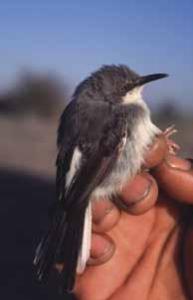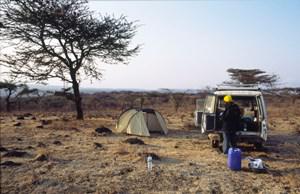Philip Shaw
Other projects
19 Jan 2002
Status and Conservation of the Karamoja Apalis in the Wembere Steppe, Tanzania I
A project focusing on the little known warbler, Karamoja Apalis, in Tanzania.

Karamoja Apalis
In 2003, a survey of the globally threatened warbler Karamoja Apalis in the Wembere Steppe, central Tanzania, confirmed that the species is largely dependent on one particular acacia species - Whistling Thorn – and showed that the warbler’s specialised habitat is less extensive in the steppe than had once been thought1. Habitat destruction, through browsing by domestic livestock and through pruning, was found to be widespread. The survey also provided an estimate of the warbler's population density, and the first recordings of its voice, which suggest that it may not be an apalis after all. Since the early 1990s there have been increasing reports of Karamoja Apalis in the Serengeti ecosystem, where its acacia habitat has expanded, perhaps as a result of changes in grazing pressure from herbivores (A.R.E. Sinclair, pers. comm.). Most apalis records have come from the north and west of Serengeti National Park, were there are extensive patches of Whistling Thorn: the warbler's main habitat. In August 2004 I located a single Karamoja Apalis north of the Masai Mara, providing a first record for Kenya. At least two pairs have since been found at this site (B. Finch, pers. comm.).

An early start in Ngorongoro Conservation Area.
In August-September 2005, with further support from the Rufford Maurice Laing Foundation, I began a survey of parts of the Serengeti ecosystem, to try to clarify the warbler's distribution, and to determine its habitat requirements within the National Park. The survey encompassed an area near to Seronera (the National Park HQ), an extensive area of Whistling Thorn at Togora Plains, to the north, and the Western Corridor. The height and density of Whistling Thorn stands in these areas was measured in a series of walked transects. The warbler's presence was detected mainly by playing recordings of its song. In the Wembere Steppe, territorial pairs had normally been highly responsive to ‘playback’, but in the Serengeti they proved to be much less-so, perhaps reflecting seasonal differences. During September, Joseph Mackubi (of the Wildlife Conservation Society of Tanzania) and I extended the survey into Ngorongoro Conservation Area (NCA), which borders Serengeti National Park. Curiously, despite an intensive search in apparently suitable habitat, no Karamoja Apalis were detected in the NCA. A subsequent visit to an area near Moru Kopjes, in Serengeti NP, produced several birds, however, within an extensive area of Whistling Thorn.
During July 2006 I plan to return to the Serengeti, to survey the south-western area of the National Park, and will then write a report describing the species’ distribution and habitat requirements within the area. Copies of the report will be provided to Tanzania National Parks and the Tanzania Wildlife Research Institute.
1 Shaw, P. & Mungaya, E. (2006). The status and habitat of Karamoja Apalis Apalis karamojae in the Wembere Steppe, Sukumaland, Tanzania. Bird Conservation International (in press).
2 Shaw, P., Mungaya, E., Mbilinyi, N. & Mbilinyi, M. (2005). The voice and bill length of Karamoja Apalis Apalis karamojae are atypical of the genus. Bulletin of the British Ornithologists’ Club 125(2): 122-129.